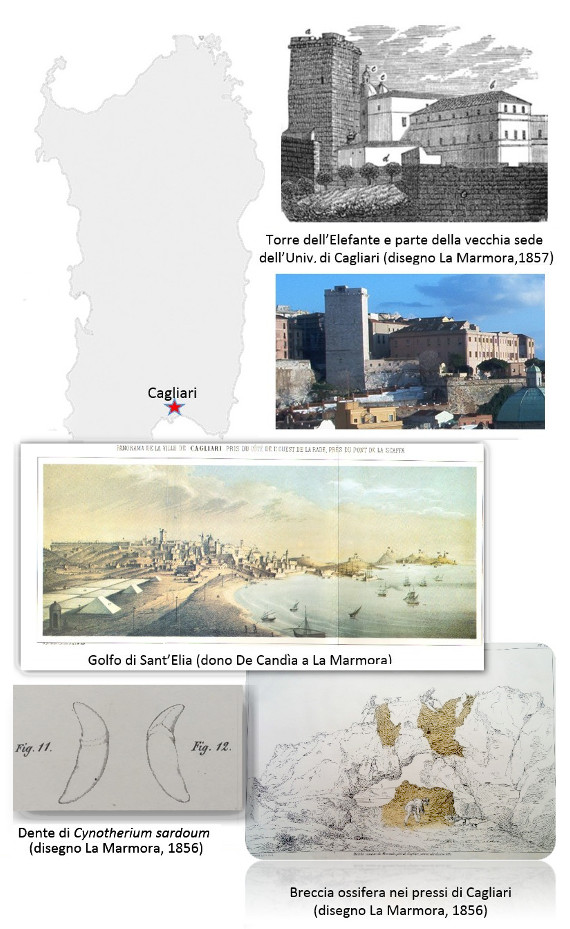Itinerary edited by UNIVERSITY of CAGLIARI 


Alberto Ferrero, Count of La Marmora, will be our guide to a corner of Sardinia called Sulcis, which is southwest of Cagliari. To this end, we will consider his research in natural sciences, archaeology and anthropology as described in his famous works Voyage en Sardaigne and Itinéraire de l’Ile de Sardaigne. He described the aim of his writing as follows: “May my work represent Sardinia as it really is and attract the Rulers’ and knowledgeable men’s attention to this county for a minute, as it undoubtedly deserves to be known better by a larger part of Europe, more than it has ever done so far”.
Alberto Ferrero, Count of La Marmora was born in Turin on 7th April 1799. At 17, he entered the Ecole Militaire de Fontainebleau where he learnt geology, geodesy and natural sciences. After Napoleon’s abdication in 1814, he became a member of the Piedmontese army and was appointed first Commissioner of Sardinia, later rising to the rank of General. His education and his several visits to Sardinia helped him study this island from a naturalistic viewpoint. This analysis was coupled with an anthropological investigation of the populations that inhabited the areas he visited.
 Cagliari
Cagliari
«Considering that, despite its various political problems, this city is the only one on the whole island that has not lost its liveliness, it seems safe to call it without exaggeration “the eternal city of Sardinia”; its foundation dates back to very ancient times and everything seems to suggest it will survive much longer»
The fossils have been collected, archived and catalogued in the La Marmora Collection – Vertebrates Section at the D. Lovisato Museum of Geology and Palaeontology
 to read about this entry:
to read about this entry:
 Pula
Pula
«A traveller who loves wooded mountains might like to hike from Pula to Monte Santo. They will reach the top in less than a three hours’ walk on a terrain made of granite and silurian, and almost entirely covered in tall holly and oak trees.»

 Capo Spartivento
Capo Spartivento
«After a long tiring walk, I managed to reach the top carrying all my geodesic and topographic instruments. I installed my station and it duly calculated the following data: 38° 51' 53" latitude and 6° 18' 54" longitude east of the Paris observatory. This is the most southern latitude that can be observed in Sardinia»

 Sant'Antioco
Sant'Antioco
«[…] Sant’Antioco is an island of extraordinary interest due to it magmatic rocks. Up until now, many have mistaken these rocks for real volcanic rocks. I will limit myself to describing the most peculiar rocks in the region, which are the perlite that can be found in the area known as ‘Grotta dei Colombi’ (Doves’ Cave). All the houses in Sant’Antioco were built using the remains of other ancient buildings. The stones were used to build new walls without following any unifying criteria; there are some well-cut porphyric stones of different shapes as well as remains of Roman columns, marble inscriptions, pieces of statues, etc.»

 Carloforte
Carloforte
«South of the San Pietro island, there is a place called “punta delle Colonne” (Columns Promontory) where trachyte stones display peculiar shapes; in Part III of my book Viaggio in Sardegna, I included a view of this place that I will reproduce here as well»


 Gonnesa
Gonnesa
«Any geologist who visits the places I am describing here will need to pay a visit to an extremely peculiar sandstone deposit near the Morimentu fountain, which can be found between the Nuraghe structures and the village of Gonnesa»
 to read about these entries:
to read about these entries:
 Domusnovas
Domusnovas

 Siliqua
Siliqua
«La grande strada che collega Domusnovas a Cagliari passa per il popoloso villaggio di Siliqua, così denominato probabilmente dall'abbondanza di carrubi (Ceratonia siliqua L.)»
 Fluminimaggiore
Fluminimaggiore
«As can be seen, this coin shows a temple with four columns on the façade, which clearly resembles the remains of a temple in Antas. A closer look at this side of the coin reveals the following letters (from left to right): Q.A.M.PC.II V. These could be read as Quintus Antonius Metallae Piae Coloniae Duumvir»
 to read about these entries:
to read about these entries:«From Antas to Fluminimaggiore, the road is almost all downhill and one must walk down a steep slope to reach Fluminimaggiore. Any geologist who follows this path will forget all about this arduous descent as soon as he enters the village and, if lucky enough, manages to extract Silurian fossils from the clayey schist upon which the houses are built, with a just few blows of his hammer»
